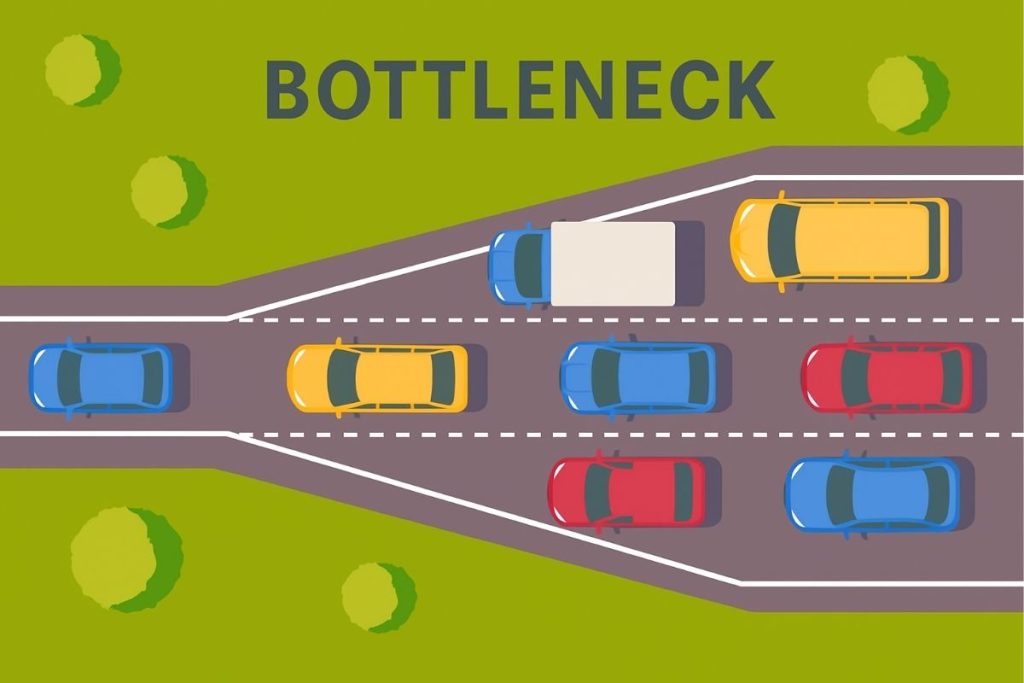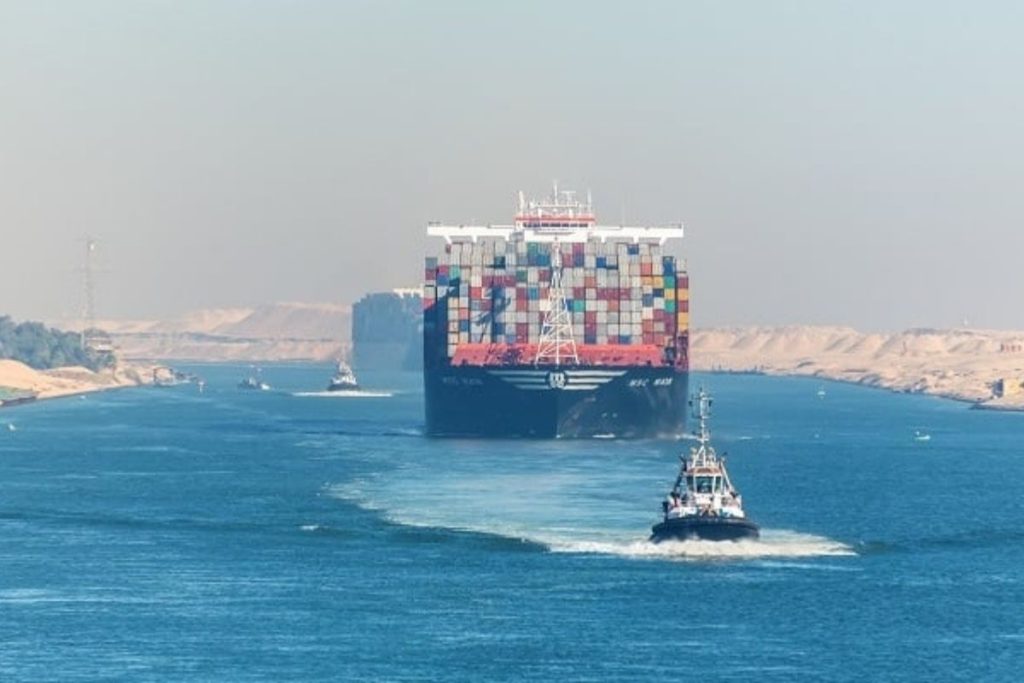Have you ever noticed what happens when you exit an expressway? The road is wide with many tracks, and traffic flows smoothly. But as you keep driving, you often see a sign that says “Road Narrows Ahead.” At that moment, you know the wide road is about to merge into fewer tracks. Vehicles start slowing down, and congestion builds up because many vehicles are trying to move through a smaller space.

This concept also works with shipping. When the flow of goods passes through a point that cannot handle the same volume, the entire system slows down. This type of situation is called a bottleneck in shipping. Just like traffic congestion on a road, there is congestion in shipping.
This article will explore what a bottleneck in shipping is, its main causes, the world’s most important maritime bottlenecks, how they impact supply chains, and how the industry tries to manage them.
Introduction: Understanding Bottlenecks in Shipping
A bottleneck in shipping means a slowdown or blockage in the movement of goods. It can happen at a port, a canal, a customs checkpoint, or even at sea. Bottlenecks are not small delays. They affect the entire supply chain. If cargo is stuck at one point, ships wait longer, trucks are delayed, warehouses become full, and goods do not reach markets on time.
For example, if a container ship is waiting outside a port because there are no berths available, the delay does not only affect that ship. The cargo on board might include parts for a factory, food for supermarkets, or fuel for industries. When those goods do not arrive, production slows down, shelves remain empty, and prices increase. That is why bottlenecks in shipping are a serious problem.
Why Does Bottleneck Happen?
Bottlenecks can be caused by many different factors. Some are natural, while others are linked to infrastructure, regulations, or global events.
1. Port Congestion
Ports are the main gateways for global trade. When too many ships arrive at the same time, and the port does not have enough space or equipment, congestion occurs. Ships wait at anchorage for days or even weeks. This happened at the Port of Los Angeles during the COVID-19 pandemic when dozens of ships were stuck offshore.
2. Lack of Infrastructure
Not all ports are modern or well-equipped. Some ports have limited cranes, outdated technology, or not enough storage space. When a port cannot handle the volume of cargo, bottlenecks are created. Infrastructure is also an issue in inland transport. If there are not enough trucks, trains, or warehouses, cargo flow slows down.
3. Customs and Regulations
Every country has customs rules. Cargo needs clearance before entering or leaving a port. If customs authorities take too long to check documents or inspect containers, delays build up. In some countries, strict regulations make the process slower, creating bottlenecks.
4. Weather and Natural Disasters
Shipping depends heavily on weather. Storms, fog, and hurricanes can stop ships from entering or leaving a port. Natural disasters such as earthquakes, floods, or tsunamis can damage port facilities. For example, typhoons in Asia often force ports to close for days. It created a large backlog.
5. Labor Strikes and Workforce Shortages
When port workers go on strike, cargo handling stops. A single strike can create weeks of delays. Even without strikes, a shortage of skilled workers can slow operations.
6. Geopolitical Events
Wars, sanctions, and political conflicts often disrupt shipping routes. The Russia–Ukraine conflict has limited access to the Black Sea, affecting grain and oil shipments. During the COVID-19 pandemic, lockdowns and restrictions created bottlenecks worldwide.
What are the Major Maritime Bottlenecks
Some bottlenecks are not just local problems. They affect the entire world. There are critical maritime chokepoints in shipping. They are narrow passages or canals where large volumes of global trade pass through every day. If one of these chokepoints is blocked, world trade slows down.

1. Suez Canal
The Suez Canal in Egypt is one of the most critical shipping routes. It connects Asia and Europe, allowing ships to avoid the long journey around Africa. In 2021, the container ship Ever Given blocked the canal for six days. Hundreds of ships were delayed, costing global trade billions of dollars. This incident showed how fragile global shipping can be.
2. Panama Canal
The Panama Canal links the Atlantic Ocean to the Pacific Ocean. However, the canal has a limited number of locks, and ships must book slots in advance. In recent years, drought has reduced water levels, forcing restrictions on vessel size and numbers. This has created bottlenecks, especially for container ships and LNG carriers.
3. Strait of Malacca
The Strait of Malacca is one of the busiest shipping lanes in the world. It is located between Malaysia, Singapore, and Indonesia. It is the shortest route between the Indian Ocean and the Pacific Ocean. Millions of barrels of oil and thousands of containers pass through it daily. Any accident or blockage here would impact both Asia and the world economy.
4. Strait of Hormuz
The Strait of Hormuz is the world’s most important oil chokepoint. It is located between Oman and Iran. A large percentage of global oil shipments pass through this narrow waterway. Tensions in the region often raise fears of disruption, which immediately affects global oil prices.
5. Turkish Straits (Bosporus and Dardanelles)
These straits connect the Black Sea with the Mediterranean. They are vital for countries like Russia, Ukraine, and Turkey. During conflicts in the region, the flow of ships through these straits can be restricted, creating major bottlenecks for grain, oil, and other cargo.
How Bottlenecks Affect the Supply Chain
Bottlenecks in shipping can cause a significant impact on the entire supply chain.
- Longer Transit Times—Ships have to spend more waiting time. Because of that, goods take longer.
- Higher Shipping Costs—Delays mean ships consume more fuel, and shipping companies charge higher rates.
- Cargo Delays and Stock Shortages—Importers cannot get goods on time. It leads to shortages in industries.
- Impact on Businesses—Because of the bottleneck caused in shipping, retailers face empty shelves. Factories run out of raw materials, and exporters lose contracts.
- Consumer Consequences— Prices of items rise every day. Because of that, customers wait longer for deliveries. Bottlenecks are not just a problem for shipping companies. They affect the global economy and daily life.
Bottleneck vs. Delay: What’s the Difference?
Not all delays are bottlenecks. A delay is usually temporary and affects a single shipment or vessel. For example, bad weather may delay one ship for a day.
A bottleneck is a recurring or systemic issue that affects the flow of many ships or large amounts of cargo. For instance, if a port is always overcrowded due to lack of infrastructure, it creates a constant bottleneck.
Understanding the difference helps businesses plan better and prepare for risks.
How the Shipping Industry Manages Bottlenecks
The shipping industry is aware of bottlenecks. They invest heavily in reducing bottlenecks.
- Port Automation and Digitalization—Modern ports use automated cranes, digital tracking, and online booking systems. Automation reduces human error and speeds up cargo handling.
- Use of Technology—Technologies like AI, blockchain, and IoT help track cargo in real time, predict delays, and improve planning. This makes the supply chain more efficient.
- Alternative Routes and Transshipment Hubs—When one route is blocked, ships are sometimes diverted through alternative routes. Transshipment hubs allow cargo to be transferred between ships to reduce congestion at major ports.
- Effective Communication—Shipping companies, port authorities, and inland transport providers are working more closely together. Better communication helps to reduce waiting times and improves efficiency.
Final Thought: Why Bottlenecks Cannot Be Ignored
Bottlenecks in shipping are one of the biggest challenges for global trade. They occur due to congestion, poor infrastructure, customs delays, weather, strikes, or geopolitical issues. Major maritime bottlenecks like the Suez Canal, Panama Canal, Strait of Malacca, and Strait of Hormuz are especially important. Because disruptions there affect the entire world.
By investing in infrastructure, adopting new technology, and improving cooperation, the shipping industry is working to reduce bottlenecks. However, as global trade grows, the challenge of bottlenecks will continue.
Read Also


